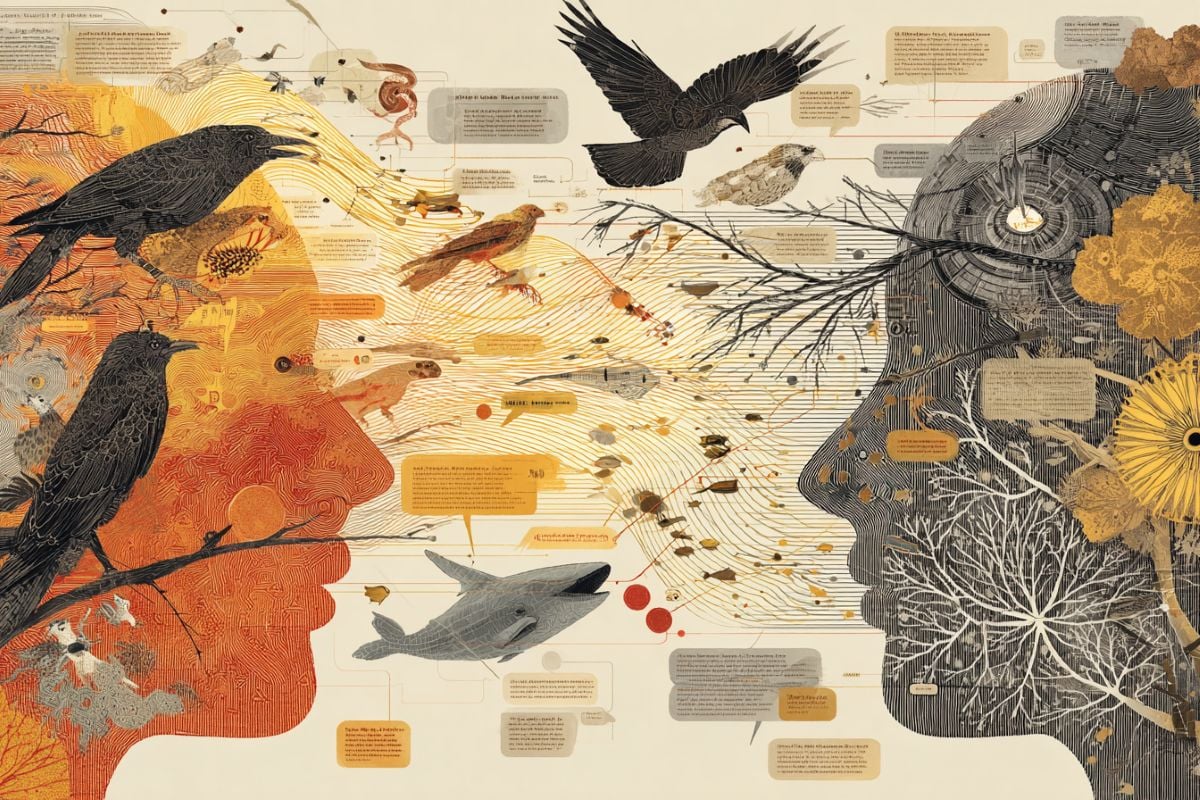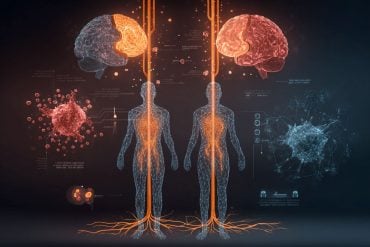Summary: A new framework argues that human language did not arise from a single evolutionary leap but from the convergence of many biological abilities and cultural processes. The authors highlight how speech learning, grammar formation, and social cooperation evolved along different paths before merging into the complex communication we use today.
By integrating insights from linguistics, neuroscience, genetics, psychology, and animal behavior, the paper challenges decades of single-origin models. This broader biocultural view clarifies how language evolved and opens new directions for studying communication, AI, and language disorders.
Key Facts:
- Multiple Roots: Language likely emerged from several interacting biological abilities and cultural processes, not from one evolutionary innovation.
- Biocultural Evolution: Vocal learning, grammar development, and social communication each have distinct evolutionary histories that converged in humans.
- Cross-Species Insight: Studying birds, bats, primates, and emerging sign languages reveals shared mechanisms that clarify how complex communication evolves.
Source: Max Planck Institute
For centuries, philosophers and scientists have wrestled with understanding how human language came about.
Language defines us as a species, yet its origins have remained a mystery. In a remarkable international collaboration, ten experts from different disciplines present a unified framework to address this enduring puzzle, harnessing powerful new methods and insights from their respective scientific domains.
“Crucially, our goal was not to come up with our own particular explanation of language evolution,” says first author Inbal Arnon, “Instead, we wanted to show how multifaceted and biocultural perspectives, combined with newly emerging sources of data, can shed new light on old questions.”
Expanding horizons
The authors stress that in the search for language origins, no single explanation is enough. Rather, language arose when different biological abilities – like the capacity to reproduce novel sounds, recognize patterns, and cooperate socially – converged with cultural processes of transmitting knowledge between individuals (both within and across generations).
“The multifaceted nature of language can make it difficult to study, but also expands horizons for understanding its evolutionary origins,” says co-author Simon Fisher. “Rather than looking for that one special thing that singles humans out, we can identify different facets involved in language, and productively study them not just in our own species but also in non-human animals from different branches of the evolutionary tree.”
Importantly, the team highlights how progress has stalled when disciplines worked in isolation from one another. To move forward, they advocate an approach that integrates learning, culture, and biology, drawing on fields as diverse as linguistics, psychology, animal communication, neuroscience and genetics. As one of humanity’s most distinctive traits, language remains a story of connection: between biology and culture, between different scientific fields, and between people themselves.
Three case studies in focus
To demonstrate the power of this framework, the researchers look at three facets whose role in language emergence becomes clearer through a biocultural lens:
- Vocal Learning: Human speech depends on our ability to learn to reproduce the vocalisations of other speakers. This skill appears to be limited in our closest primate relatives, but has independently emerged elsewhere on the tree of life. For example, some birds, bats, and whales are especially adept at vocal learning. Genetic and behavioural findings on this facet from distantly related species help us understand distinct human capacities.
- Linguistic Structure: Grammar did not simply appear in our ancestors overnight. Findings from real-life cases of sign language emergence, experiments recreating cultural evolution in the lab, and investigations in songbirds and primates highlight the importance of communication and cultural transmission – being repeatedly used and learned by multiple individuals over generations – in shaping the structure of language. This facet shows how the emergence of structure involves a convergence of biological, cognitive and cultural conditions, in a particular combination that may be unique to humans.
- Social Foundations: Language is used in interaction with other people. Studies have shown the importance of social interaction for learning human language, and also for other learned communication systems, like birdsong. Added to this, humans have an unusually strong drive to socially share information, which is rarely observed in nonhuman animals.
Biocultural perspectives on language evolution illuminate unique and shared features of the emergence of complex communication, and also pave the way for innovative research on language learning, artificial intelligence, and how communication breaks down in disorders.
Key Questions Answered:
A: That language emerged from multiple biological and cultural capacities interacting over time, not from a single evolutionary source.
A: Because language involves vocal learning, social communication, pattern recognition, and cultural transmission, requiring insights from many fields.
A: That different species share elements of vocal learning and communication, helping illuminate the evolutionary building blocks humans adapted for language.
Editorial Notes:
- This article was edited by a Neuroscience News editor.
- Journal paper reviewed in full.
- Additional context added by our staff.
About this language evolution research news
Author: Anniek Corporaal
Source: Max Planck Institute
Contact: Anniek Corporaal – Max Planck Institute
Image: The image is credited to Neuroscience News
Original Research: Closed access.
“What enables human language? A biocultural framework” by Inbal Arnon et al. Science
Abstract
What enables human language? A biocultural framework
BACKGROUND
Explaining the origins of language is a key challenge in understanding ourselves as a species. We present an empirical framework that draws on synergies across scientific disciplines to facilitate robust studies of language evolution. The approach is multifaceted, seeing language emergence as dependent on convergence of multiple capacities, each with their own evolutionary trajectories.
It is explicitly biocultural, recognizing and incorporating the importance of both biological preparedness and cultural transmission as well as interactions between them. Biocultural and multifaceted perspectives are increasingly appreciated, but there remains a need to integrate them within a unified framework and demonstrate how this advances understanding.
We do so in this paper through three case studies examining the evolution of different facets of human language (vocal production learning, linguistic structure, and social underpinnings), each synthesizing the latest findings from multiple fields to generate valuable insights and setting a new agenda for future research.
ADVANCES
Case study 1 considers vocal production learning, an organism’s capacity to enlarge and modify its repertoire of vocalizations based on auditory experience. This ability is crucial for learning spoken language and limited in nonhuman primates but has emerged in other branches of the evolutionary tree, including subsets of birds, bats, elephants, cetaceans, and pinnipeds.
Bringing together data from molecular investigations of speech and language disorders, genetic manipulations in animal models, and studies of ancient DNA, this case study demonstrates how ancient genetic and neural infrastructures may have been modified and recombined to enable distinctive human capacities.
Case study 2 examines the emergence of linguistic structure, a defining property of human language, using data from real-world cases of emergence (e.g., homesign and emerging sign languages); experiments recreating cultural evolution in the lab; and comparative studies of nonhuman animals, including songbirds and primates.
This case study highlights the importance of transmission and interaction, suggesting that emergence of structure involves a combination of biological, cognitive, and cultural conditions: Although some (or all) traits are shared with other species, their combination may be specific to humans.
Case study 3 focuses on the social underpinnings of communication across species. Social interaction contributes to language learning in humans and learned behaviors in other species with culturally transmitted communication systems, such as songbirds. But humans also demonstrate a strong internal drive to socially share information, which is rarely observed in nonhuman animals.
OUTLOOK
Drawing on diverse data, the case studies show how modification and recombination of abilities present in nonhumans, combined with intra- and intergenerational cultural transmission, may yield linguistic capacities in our own species.
This perspective increases the range of species relevant for understanding language origins, as different abilities may be present across different branches of the evolutionary tree.
The case studies also demonstrate the value of explicit biocultural framing, where both biological preparedness and cultural evolution shape language emergence.
Language evolution is impacted by three distinct but interacting timescales: the individual (language learning), the community (cultural evolution), and the species (biological evolution). Understanding how the timescales interact and constrain one another requires synergies of data, methods, and fields.
A recurring theme and avenue for future research is the role of biological reward systems in language evolution, including the motivation to communicate and endogenous and exogenous rewards for successful imitation and communication.
Our integrative framework shows how research across disciplines and methods can advance understanding of a fundamental question in human evolution.







